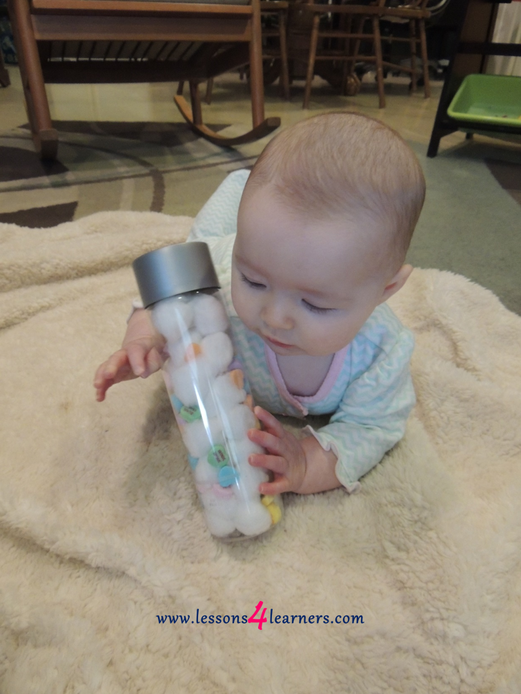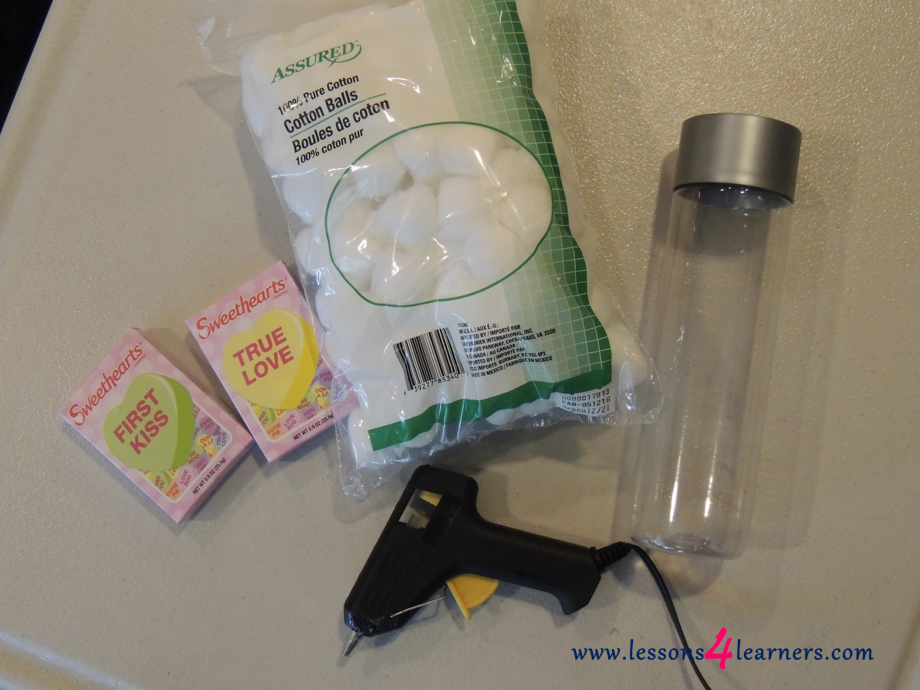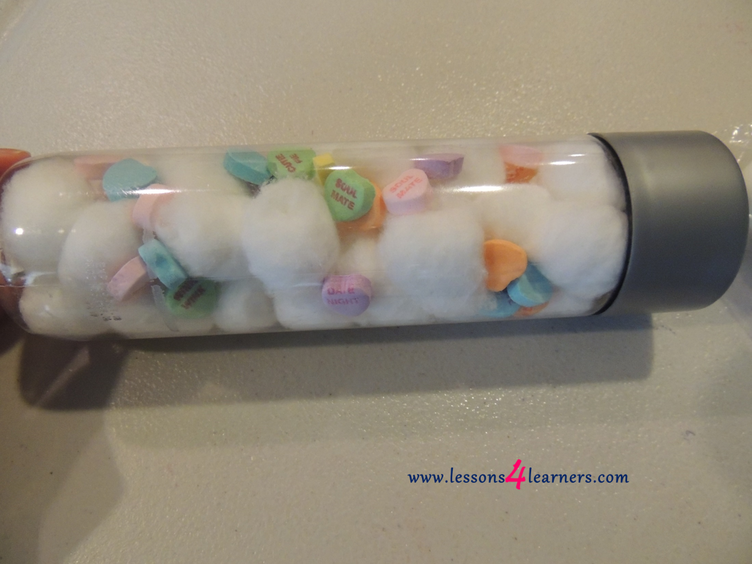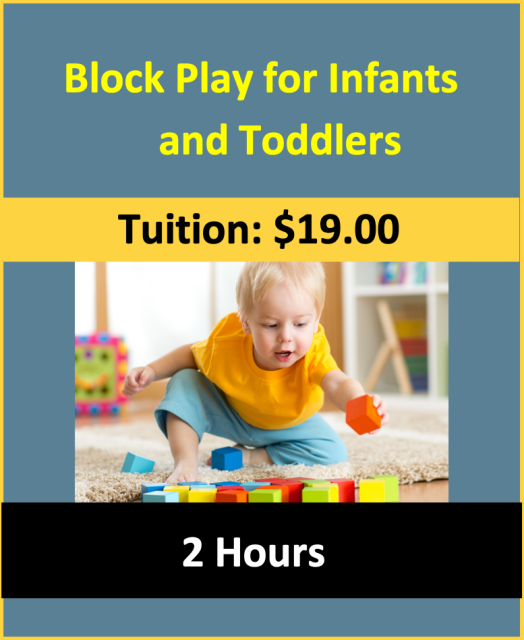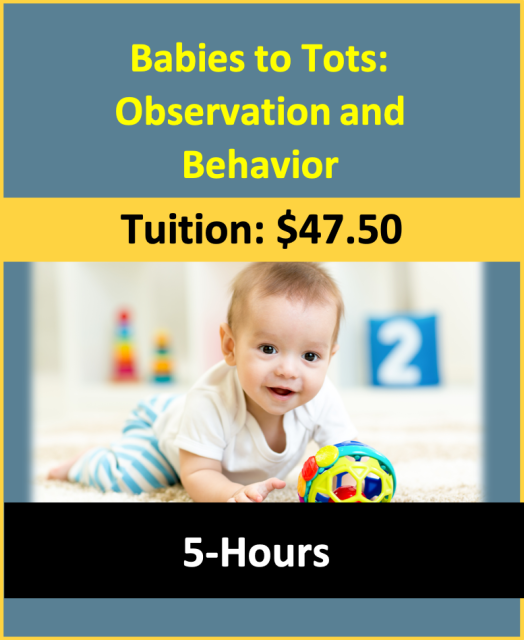Conversation Hearts Sensory Bottle
Lesson Plan:
|
Activity:
Conversation Hearts Sensory Bottle Lesson plan developed by Ms. Erika Geelhoed, BA Ed Age Group: Young Infants * Lesson plan objective and assessment can be adapted to use this activity with mobile infants, toddlers or preschoolers. Objectives: Children will:
|
|
II.4.3a
Materials:
|
Procedure:
- Create the sensory bottle by filling the empty water bottle with the candy hearts and cotton balls.
- Glue the lid of the water bottle on using the hot glue gun to prevent the children from opening it.
- Place the sensory bottle and the children in an appropriate area for exploration.
- As the children plays, stay with them on the floor and converse with them about what they are experiencing, giving them new vocabulary.
*** Make sure that the lid is glued on securely! *** Do not walk away from the children during sensory play. Do not place sensory items in the crib with the children.
Assessment:
- Observe and record the children’s gross motor skills. How long were they able to remain in tummy time before becoming fussy? Did they reach out for the bottle? How did they react to it? Record these observations and place them in the children’s portfolio along with pictures of the activity.
Click on the course icon for enrollment information.
Babies Who Hate Tummy Time
As a child care provider, it is inevitable that you will come in contact with an infant that does not love tummy time. Here are a few suggestions for making it more enjoyable for both you and baby:
Do it with them.
During tummy time, position yourself at eye level to interact with the child. Encourage them by talking, singing, and making funny faces. Tummy time is a wonderful time to bond and socialize with the child.
Comfort them.
Infants will want to know that you are close by during this unfamiliar time. You can rub or pat the child’s back to soothe them.
Make it fun!
When in doubt, distract! Provide the infant with plenty of sensory activities to keep them occupied. Sensory boards, bottles, toys, and of course mirrors can be used to make the experience engaging for little ones. Remember that a baby’s eyesight is not fully developed, so they may have trouble seeing objects. Help them out by using items that are primary colors or high in contrast (black and white).
Go slow.
If a child is having a particularly hard time, start out with even less time on their front than recommended. Even if they just do 30 seconds at a time, it is beneficial to their development.
Don’t force it.
If you place a child on their stomach for tummy time and they begin to become upset, remove the child from the position. Tummy Time should not be a “tough it out” type of experience.
Make it comfortable.
Place a rolled up blanket or boppy under the child’s armpits to prop them up. Doing so makes it so the infant doesn’t have to work as hard to look up. This can be helpful for infants who are just beginning a tummy time routine.
Mix it up.
Just like adults, children crave variety. Try alternating tummy time positions (on a balance ball, “football hold”, on the ground, ect.) and activities to help prevent boredom.
During tummy time, position yourself at eye level to interact with the child. Encourage them by talking, singing, and making funny faces. Tummy time is a wonderful time to bond and socialize with the child.
Comfort them.
Infants will want to know that you are close by during this unfamiliar time. You can rub or pat the child’s back to soothe them.
Make it fun!
When in doubt, distract! Provide the infant with plenty of sensory activities to keep them occupied. Sensory boards, bottles, toys, and of course mirrors can be used to make the experience engaging for little ones. Remember that a baby’s eyesight is not fully developed, so they may have trouble seeing objects. Help them out by using items that are primary colors or high in contrast (black and white).
Go slow.
If a child is having a particularly hard time, start out with even less time on their front than recommended. Even if they just do 30 seconds at a time, it is beneficial to their development.
Don’t force it.
If you place a child on their stomach for tummy time and they begin to become upset, remove the child from the position. Tummy Time should not be a “tough it out” type of experience.
Make it comfortable.
Place a rolled up blanket or boppy under the child’s armpits to prop them up. Doing so makes it so the infant doesn’t have to work as hard to look up. This can be helpful for infants who are just beginning a tummy time routine.
Mix it up.
Just like adults, children crave variety. Try alternating tummy time positions (on a balance ball, “football hold”, on the ground, ect.) and activities to help prevent boredom.
